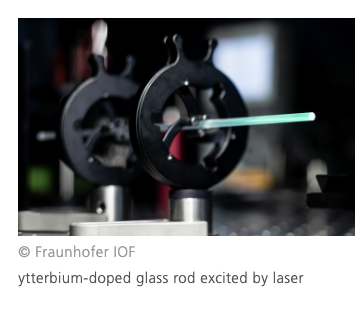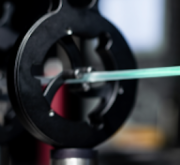日本語で読みたい方は、
google chromeで開いて、
画面上で右クリックをして
「日本語に翻訳」をクリックしてください
For the first time, a team of researchers from the Fraunhofer Institute for Applied Optics and Precision Engineering IOF and the University of New Mexico have succeeded in cooling silica glass by 67 kelvins through optical laser cooling. The researchers from Jena and Albuquerque have now published the results in the journal Optics Express.
Cutting, drilling, welding – we usually associate laser light with the heating of materials, to, e.g., work with precision on objects made of metal or stone. But under specific circumstances, it is also possible to cool materials through radiation with laser light – an effect that is known for the Doppler cooling of gases. However, laser radiation can also cause cooling in solids.
This paradoxical effect becomes possible through so called anti-Stokes fluorescence cooling. In this process, a special, high-purity material is excited via laser light radiation. Due to the difference in energy between the excitation laser and the radiation emitted by the material, i.e., the fluorescence, energy is extracted from the material in the form of heat – it is cooled.
A research team consisting of Fraunhofer IOF and University of New Mexico researchers have studied the laser cooling of doped silica glass and accomplished a significant development in their now published paper.
Researchers overcome previous cooling threshold of silica glass again

For many years, the cooling of silica glass was considered impossible. But in 2019, researchers from Jena and Albuquerque were able to prove the laser cooling of ytterbium-doped silicia glass for the first time. Back then, the cooling only reached 0.7 kelvins from room temperature. To overcome the previous cooling threshold, the specific process for manufacturing the doped material as well as its exact composition were optimized. Moreover, the excitation lasers used for the measurements conducted by the University of New Mexico were improved in close collaboration with Fraunhofer IOF researchers.
As a result, the researchers have now achieved a new record-breaking cooling: Through the radiation of an ytterbium-doped silica rod by an excitation laser with a power of 97 watts and a wavelength of 1032 nanometers, the researchers were able to prove a temperature reduction from room temperature by 67 kelvins within two minutes.
Fiber-like materials opens up new potentials for application
Because of this new development, novel, extremely stable lasers and low-noise amplifiers for precision metrology or quantum experiments can be developed in future. Moreover, the optimized process can advance vibration-free cooling and thereby open up new potentials for application in materials analysis and medical diagnostics through cryomicroscopy and gamma spectroscopy.
The potential use of the material in fibers is particularly interesting. In future, the new process could be used to develop high-performance fiber lasers that do not have to deal with the limiting effects of thermal instability.
The new process represents a significant advance in laser cooling and, according to the experts’ theoretical considerations, does not mark the greatest possible temperature reduction using laser light yet.
Original publication
Brian Topper, Stefan Kuhn, Alexander Neumann, Alexander R. Albrecht, Angel S. Flores, Denny Hässner, Sigrun Hein, Christian Hupel, Johannes Nold, Nicoletta Haarlammert, Thomas Schreiber, Mansoor Sheik-Bahae, and Arash Mafi: »Laser cooling ytterbium doped silica by 67 K from ambient temperature«,
Optics Express 32, 3660-3672 (2024),
DOI: 10.1364/OE.507657,
URL: https://opg.optica.org/oe/fulltext.cfm?uri=oe-32-3-3660&id=545710.
(株)光響が提供する製品・サービス情報:
・独・フラウンホーファー研究機構(機構の概要)
・同機構の「直接レーザー干渉パターニング技術」を用いた加工品
出典:
https://www.iof.fraunhofer.de/en/pressrelease/2024/research-team-succeeds-in-cooling-silica-glass-by-a-record-67-ke.html
In case of addition or removal of the article, please contact us as below:
info@symphotony.com
この情報へのアクセスはメンバーに限定されています。ログインしてください。メンバー登録は下記リンクをクリックしてください。

